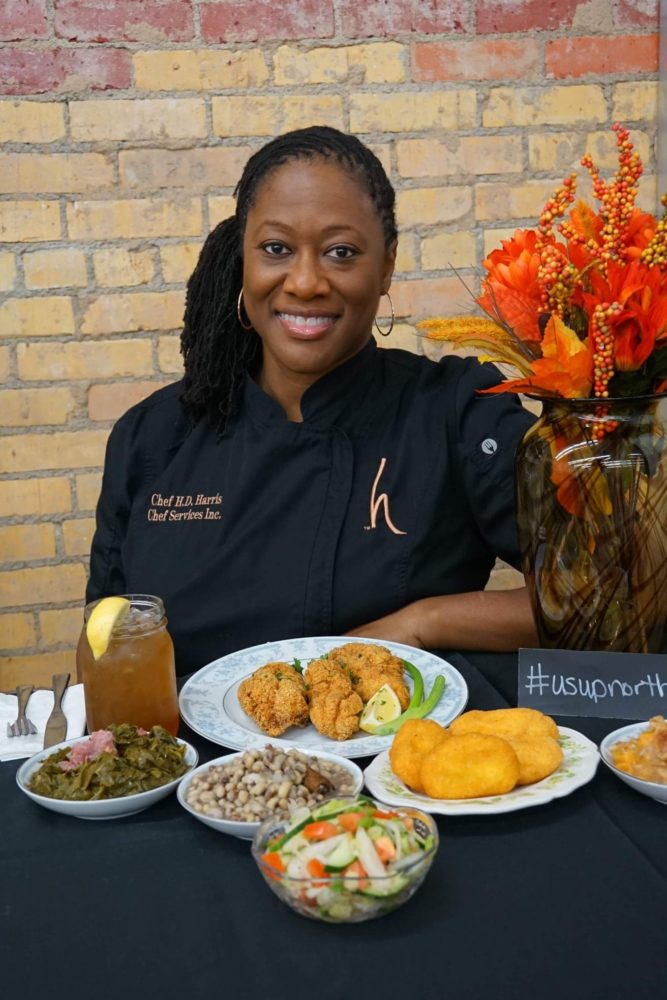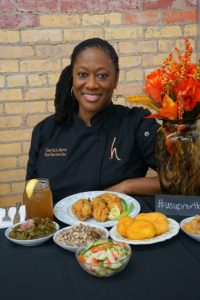Northern Hospitality
An interview with Chef Hardette Harris, the curator of the Official Meal of North Louisiana
Published: August 30, 2019
Last Updated: June 25, 2023

Photo by Leronn Burris, Burris Productions
Chef Hardette Harris
Chef Hardette Harris has emerged as an advocate for the recognition of Louisiana’s distinctive foodways, offering cooking demonstrations and food tours and even going so far as to curate the Official North Louisiana Meal. She sat down with 64 Parishes managing editor Chris Turner-Neal to talk about what graces tables north of I-10 . . . and even I-20.
Do you think it’s fair to say that you’ve made a name for yourself as an ambassador for North Louisiana food?
I guess I have. I still feel like I’m just cheerleading for North Louisiana cuisine, but I’ll take ambassador.
Tell me how you started advocating for this food culture to get more recognition.
I’ve always called myself a professional foodie because I love to cook. I knew I wanted to be a private chef. I wanted that intimate feel of cooking just like at home. Someone told me Shaquille O’Neal had his own private chef and he made x dollars for cooking one plate. So I went to [a] culinary school, enrolled, and then I said, “That’s kind of stupid. How would I be a chef if I’m allergic to shellfish?” I’m severely allergic. So I didn’t go.
Then two years later I decided that’s what I want to do. I want to be a chef; I’ll just figure it out. Got my first client while I was still in culinary school. Finally found my first full-time, private client. And it turns out being a private chef is as wonderful as it sounds.
Over the years, though, I noticed that North Louisiana cuisine had become South Louisiana cuisine. People cook gumbo here, people cook étouffée here, but those aren’t our traditional dishes. As soon as I got back from working for private clients in Texas, I said I’m going to have a dinner of our food. I had it in Minden, and my state representative was there. He said, “I love what you’re doing. I had some friends in town who were looking for our food, and there was nowhere to go. If you ever need anything, let me know.” I’d been told if a politician offers you something you better get on it, because they have short memories.
I said [to him], I think I need a guide to say: here’s what we’re proud of. When I started researching, there was nothing that we were pushing as our food, nothing. We were all “mudbug,” we were everything that we aren’t.
I did some more research and saw that Oklahoma had an “official meal.” So I called my representative, and I said, “How does this work?” The representative’s office said, “Let me call Baton Rouge and see what they say.” She called me back and said, “They want to know what you want on the official meal.” I’m like, well, I was just making a phone call.
So I took two days, wrote out a proposed meal, sent it to her. She called me one day and said, “They’re going to read it during this legislative session.” Just like that. It became House Concurrent Resolution #88, the Official Meal of North Louisiana. No other state has a state meal except this one that I developed and Oklahoma. That’s the long answer of how this journey started. When I’m giving presentations, I talk about how necessary this was, how people are really accepting that North Louisiana does have its own flavor.
Tell me about the official meal.
The official meal is not just a plate. It starts out with a Natchitoches meat pie because the Natchitoches meat pie is already the official state meat pie. Then we move into main dishes like barbecue chicken, ribs, fried chicken, fried catfish. Then our peas and beans category, like purple hull peas and pinto beans, and then greens, like cabbage, mustard, and turnip greens. Side dishes, like sweet potatoes, rice and gravy, potato salad. And desserts: pound cake, peach cobbler, pecan pie, and watermelon fruit salad. Then our condiments: mayhaw jelly, hot sauce, pepper sauce. Finally, our beverage is just sweet tea.
I get a lot of “Isn’t this just soul food?” And a lot of these items are found on the soul food plate because it’s a Southern thing. But this meal is mostly about celebrating what we grow or source here naturally, like peaches and pecans, or freshwater fish. When we have a celebration, we’re in the backyard celebrating a birthday party or whatever, we’re back there frying fish. We’re back there barbecuing. We’re not back there with a big giant pot of gumbo.
How far south does North Louisiana go? Where do you see the food culture change?
I cut it off at Natchitoches. You get into some of the South Louisiana stuff right there in the Natchitoches/Cane River area. That’s where I see the differences.
A lady told me once, “I used to live in New Orleans, and I recently moved here. You know what I missed in New Orleans? Vegetables.” And it hit me like a ton of bricks. There aren’t a lot of vegetables on the South Louisiana plate. Just a lot of gravies and proteins. But here, we have plates of peas and beans and greens. When you fly into Shreveport, there’s a big picture in the airport of crawfish. That should be a big platter of catfish.
